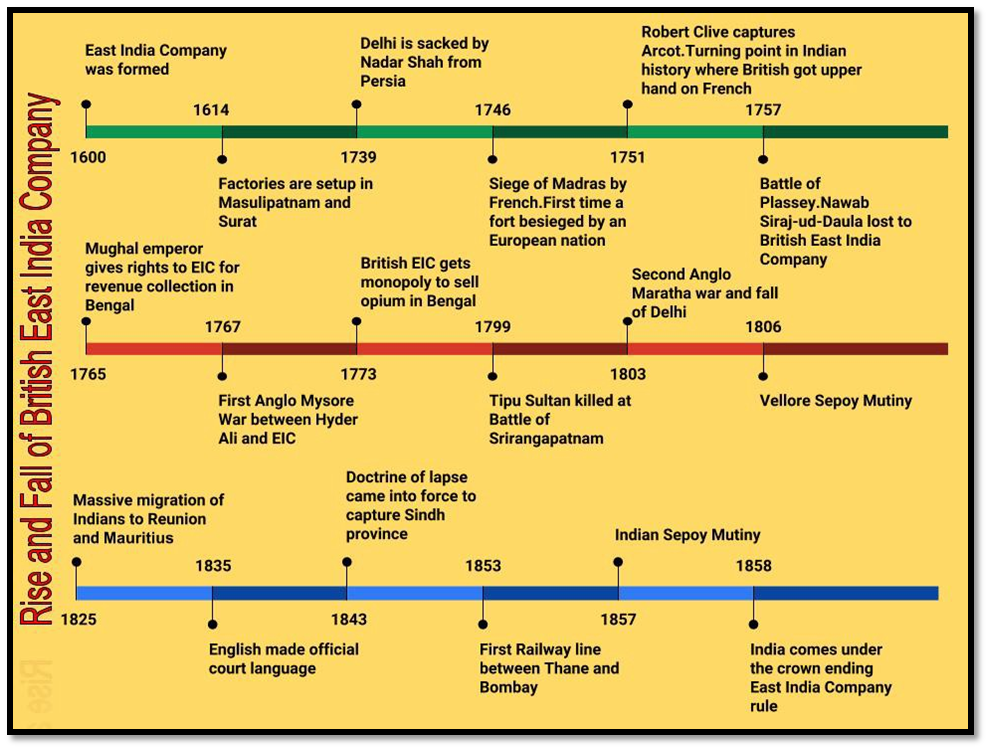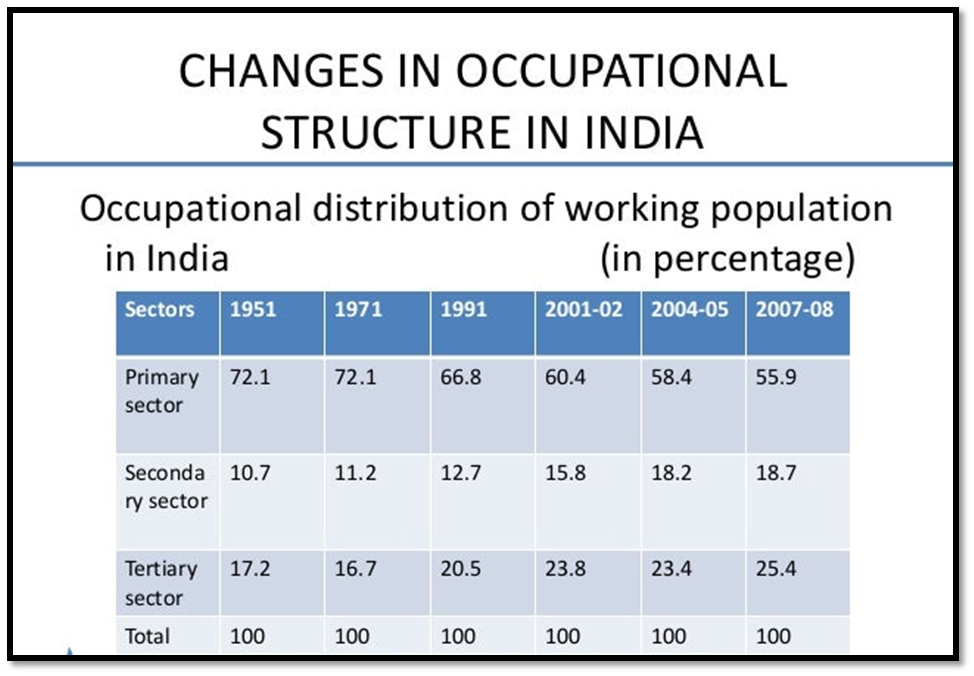ADVENT OF EAST INDIA COMPANY IN INDIA
COLONIALISM
Definition: Colonialism is a general description of the state of subjection political, economic, and intellectual of a non-European society as a result of the process of colonial organization. Colonialism deprives a society of its freedom and its earth and, above all, it leaves its people intellectually and morally disoriented.
Origin of British Rule
The British rule over India changed the course of history in India. The foundation of British Empire in India was laid by battle of palsy, fought in 1757.
Basic Purpose of British rule
The main purpose of the British rule in India was to use Indian economy as feeder economy for the development of the British economy. British colonial rule tempered the Indian economy very badly. They exploited India’s natural as well as human resources for the glory of their own country. Finally, after 200 years of British rule, India gained independence from them on the 15th August 1947.
Basic Chronology of British Rule

INDIAN ECONOMY BEFORE COLONIAL RULE
Indian Economy before Colonial Rule
- Before the advent of colonial rule, India was a self-sufficient and flourishing economy. Evidently, our country was popularly known as the golden eagle. India had already established itself on the world map with a decent amount of exports. Although primarily it was an agrarian economy, many manufacturing activities were budding in pre-colonial India.
- Indian craftsmanship was widely popular around the world and garnered huge demands. The economy was well known for its handicraft industries in the fields of cotton and silk textiles, metal and precious stone works, etc. Such developments lured the British to paralyze our state and use it for their home country’s benefits.
Agriculture
- During the pre-British era, a major part of India’s population was dependent on agriculture. The farming technologies and irrigation facilities were not satisfactory. However, agriculture in villages was self-sustaining and independent.
- The village communities either purchased or consumed the raw materials and articles directly. Consequently, starvations and famines were rare if not frequent. Of course, agricultural practices remained primitive, but the villages functioned independently and were self-sufficient. All of this went for a toss when the Britishers set feet on the Indian subcontinent.
Industrial Sector
- Before the rise of the British Empire in India, it was known for its handicraft industry. Evidently, this industry enjoyed worldwide demand and was held in high regard. Indian craftsmanship was applauded in all parts of the world. The textile industry was among the most important urban handicraft industry. Articles made up of wool, cotton and silk were famous both inside and outside the country’s boundaries.
- Additionally, various metal industries, stone carving, marble work, shipbuilding, tanning, and leather industries were taking shape. These industries potentially accelerated India’s growth, establishing it on the world map. However, the British Raj took every step to ensure that this was not the case.
Foreign Sector
- Pre-colonial India enjoyed a worldwide market for its manufactured products. The excellent levels of craftsmanship were held in high regard and enjoyed a global reputation. Notable ones are handicrafts and textile industries. Shawls and carpets from Kashmir and Amritsar, silk sarees of Banaras and silk cloth of Nagpur are some examples.
- Pre-British India also excelled in the artistic handicraft industry which includes jewelry made of gold and silver, brass, copper and bell metal wares, marble work, carving works in ivory, wood, stone, artistic glassware etc. All of the above-mentioned items including cinnamon, pepper, opium, indigo etc. constituted a major proportion of exports from India. Effectively, India was exporting high-quality manufactured goods to European countries and owned a respectable share in the world economy.
BRITISH POLICIES AND THEIR IMPACT ON INDIA
AGRICULTURAL SECTOR
- During the pre-British period, the condition of Indian Agriculture was not at all satisfactory.
- Nearly 85% of the country’s population lived mostly in villages and derived livelihood, directly or indirectly from agriculture.
- Even with this large proportion of the population engaged in agriculture, the country was not self-sufficient in food and raw material for industry.
Agriculture on the Eve of Independence:
- Low Production and Productivity:
Production refers to the total output and Productivity refers to output per hectare hand, both were very low at the time of Independence.
- High Degree of Uncertainty: Agriculture in India was heavily dependent on rainfall, due to the lack of permanent means of irrigation (dams, wells) and no efforts by Britishers were made to strengthen the agricultural sector.
- The dominance of Subsistence Farming: Subsistence farming means farming that is done just to meet the basic needs of the farmer (and his family). In India, subsistence-based farming was done resulting in little or no surplus left for sale meaning that there was a lack of commercial outlook. This lead to the backwardness of the agricultural sector and the nation.
- Difference/Gulf between the Owners of the Soil and the Tillers of the Soil: The owners of the soil shared the output with the tillers but they did not share the cost of production. The owners were simply interested in increasing their income in terms of share of output. For tillers agriculture was a source of subsistence and for the owners, it was a source of income without investment creating a wide economical gap between two.
- Small and Fragmented Holdings: There were small and fragmented landholdings leading to low output at a high cost of production, therefore, landholdings were uneconomical.
- Zamindari System or Land Revenue System under the British Raj:
During the British Rule, a unique land revenue system was introduced in India. Under this system, a triangular relationship was set up between the government, the owners and the tillers of the soil. This system was called “The Zamindari System”.
Features of the Zamindari system are as follows:
-
- Zamindars were recognized as the permanent owners of the soil.
- Zamindars had to pay a fixed sum or revenue to the government as land revenue and if they were unable to do so, they stood in danger of losing their rights.
- Zamindars were free to extract as much as they want from the tillers of the soil as they wished and could.
Problems with the Zamindari System:
- Unlimited exploitation of the tillers of the soil by the zamindars.
- High rates of land revenue to be paid by tillers.
- Tillers were reduced to the status of landless laborers resulting in earnings just to meet their basic needs.
Forced Commercialisation of Agriculture:
Commercialization meant that there was Shift from cultivation for SELF- CONSUMPTION to MARKET.
REASON: The British rule in India collided with the Industrial Revolution in Britain; therefore, this commercialization of crops was done to meet the requirement of the Indigo that was used by the textile industry in Britain for the purposes of dying/bleaching.
How was this done?
- The farmers were forced to accept the advance payments for the cultivation of the Indigo.
- Earlier farmers grew grain for their family’s consumption but now they needed cash to buy it from the market.
- There were uncertainties in the market due to which the farmers became indebted.
- This indebtedness of farmers leads to the stagnation and backwardness of agriculture.
CONCLUSION: All these reasons combined showed that the Agriculture sector on the eve of independence was backward and stagnant.
INDUSTRIAL SECTOR
- Although agriculture had dominated, the Indian Economy during the pre-British period, some Indian industries like the handicraft industries, enjoyed worldwide reputation.
Industrial Sector on the eve of Independence:
Reasons behind the decay of handicrafts:
1. Discriminatory Tariff (Tax) Policy of the State - Britishers found India's best source of raw materials and best market for their finished goods. They started the following discriminatory tariff policies:
- The export of raw materials from India tariff-free.
- The import of British Industrial products to India tariff-free.
- Heavy duty (taxes) was placed on the export of Indian Handicraft products. British finished products captured Indian markets. Therefore, the decay of the handicrafts was the result.
2. Disappearance of the Princely Courts
- At the time of Independence India was divided into two sets of territories:
- The law of British India was placed in both the central and the local governments, which means that the Princely states somehow existed under the influence of the law.
- Local rulers encouraged (patronize) the handicrafts making them reputed worldwide, with the greater influence of British law and their discriminatory policy the decay of handicrafts took place.
3. Competition from Machine- made Products-
The machine-made products from Britain were low-cost and gave tough competition to handicrafts products in India. This competition forced the Indian craftsmen to shut their enterprises forever.
4. New Patterns of Demand-
The impact of the Britishers can be seen on our culture and thinking too. This led to the emergence of the new class and new patterns of class that preferred British products to Indian products.
5. Introduction of Railways in India-
Railways were introduced in India by the Britishers for their own selfish motives in order to expand their markets for the finished products in India. Their expansion leads to decay in handicrafts.

FOREIGN TRADE UNDER BRITISH RULE
Observations:
- Net Exporter of Primary Products and Importer of Finished Goods- India under British rule became an exporter of raw materials (cotton, wool, indigo, etc.) and an importer of finished goods. The composition of exports and imports showed the backwardness of the economy.
- Monopoly control of India’s Foreign Trade- British government monopolized the exports and imports soft the country in a way that, More than 50% of trade with Britain only. Imports of Britain’s finished goods provided a huge market to British industry in India.
- Drain of Indian wealth during British rule-
Despite the exports exceeding our imports, there was mass export of primary goods, which is a sign of economic backwardness. The trade surplus was used for administrative and war expenses of Britishers and not for the growth and development of the country.
DEMOGRAPHYDURING COLONIAL RULE
DEMOGRAPHIC PROFILE DURING BRITISH RULE
Demographic condition during the British rule exhibited all features of a stagnant and backward Indian economy.
- First official census: The first official census was conducted in the year 1881. Though suffering from certain limitations, the census revealed unevenness in India’s population growth. From 1881 onwards, census operations were carried out after every 10 years.
- 1921: Year of the great divide: Before 1921, India was in the first stage of demographic transition. The second stage of transition began after 1921. So, the year 1921 is described as the ‘Year of the Great Divide’.

1. Birth Rate and Death Rate- Birth rate refers to number of children born per thousand in a year. Death rate refers to number of people dying per thousand persons in a year. Both were very high, at nearly 48 & 40 per thousand and this suggested a state of massive poverty in the country.
2. Infant Mortality Rate- Infant mortality rate refers to number of infants dying before reaching one year of age per 1000 live birth in a year. The infant mortality rate was about 218 per thousand, in contrast to the infant mortality rate of 44 per thousand in 2011.
3. Life Expectancy- Life expectancy refers to the average number of years for which people are expected to live. The average life of a person living in India at that time was just 32 years, which meant that there were poor medical facilities, and a lack of awareness and means to avail themselves.
4. Literacy Rate- It was as slow as 16% and the female illiteracy rate was even worse reflecting social and economic backwardness along with gender bias. It means the structure of the working population across all three sectors of an economy I.e. primary, secondary and tertiary.
5. Widespread Poverty- Extensive poverty prevailed in India during the colonial period. The overall standard of living of common people in India was very low and there was widespread poverty in the country.
6. Poor Health Facilities: Public health facilities were either unavailable to large mass of population or, when available, were highly inadequate. As a result, water and air-borne diseases were widespread and took a huge toll on life.
OCCUPATIONAL STRUCTURE IN COLONIAL INDIA
OCCUPATIONAL STRUCTURE
Occupational structure refers to the distribution of working persons across different industries and sectors. During the colonial period, the occupational structure of India showed little sign of change.
Occupational structure on the eve of Independence:
1. Agriculture as Principal source of Occupation- With a large number of the working population engaged in agriculture, it became the source of livelihood and their only source of occupation. This shows the backwardness of the country in terms of lack of employment outside agriculture.
2. The industry as an Insignificant Source of Occupation- Very few people were engaged in the industrial sector, this proves the backwardness of the Indian economy on the eve of Independence.
3. Unbalanced Growth- Only when all the sectors of the economy are equally developed there is balanced growth, but in the case of India except for agriculture all the other sectors were in the infant stage leading to the backwardness of the country.

INFRASTRUCTURE DURING THE BRITISH RULE
INFRASTRUCTURE ON THE EVE OF INDEPENDENCE
The economic and social elements of Infrastructure remained undeveloped except for the Railways, Ports and a few roads made and introduced by the Britishers for the transportation of raw materials from one place to another smoothly.
The state of infrastructure:
- Roads: The colonial administration could not accomplish much on the construction of roads due to scarcity of funds.
- The roads that were built, primarily served the interests of mobilising the army and shifting raw materials.
- There always remained an acute shortage of all-weather roads to reach out to rural areas during the rainy season. As a result, people living in these areas suffered badly during natural calamities and famines.
- Railways: The most important contribution of British rule was to introduce railways in India in 1850. The railways affected the structure of the Indian economy in two important ways:
- Railways enabled people to undertake long distance travel. It broke geographical and cultural barriers and promoted national integration.
- It enhanced the commercialization of Indian agriculture, which adversely affected the comparative self-sufficiency of the village economies in India. Railways also promoted foreign trade but it benefited the Britishers more than the Indians. The construction of railways First Railway Bridge linking led to huge economic losses for the Indian economy.
- Air and Water Transport: British Government took measures for developing water and air transport. However, their development was far from satisfactory.
- Inland waterways proved to be uneconomical, as in the case of the Coast Canal on the Orissa coast. This canal was built at a huge cost, but it failed to compete with the railways, and finally, canal had to be abandoned.
- Communication: Posts and telegraphs were the most popular means of communication.
- The introduction of the expensive system of electric aviation, in 1932 telegraph in India served the purpose of maintaining law and order.
- The postal services, despite serving a useful public purpose, remained inadequate.
Reasons for Infrastructural Development
The basic objective of the British Government to develop infrastructure was not to provide basic amenities to the people but to serve their own colonial interests.
1. The Roads were built for mobilizing the army within India and for drawing out raw materials from the countryside to the nearest railway station or port and to send these to England or other lucrative foreign destinations.
2. Railways were developed by the Britishers mainly for three reasons:
- To have effective control and administration over the vast Indian territory;
- To earn profits through foreign trade by linking railways with major ports.
- To make a profitable investment of British funds in India.
3. The system of Electric Telegraph was introduced at a high cost to serve the purpose of maintaining law and order
IMPACTS OF BRITISH RULE
POSITIVE IMPACT OF BRITISH RULE IN INDIA
- Commercial Outlook of Framers- Forced commercialization of agriculture by the Britishers forced the farmers to have a commercial outlook as they started producing more(in terms of quantity and diversity) for the market and not just for subsistence.
- New Opportunities of Employment- Introduction of railways meant new employment opportunities outside agriculture.
- Control of Famines- Not more starvation or death due to lack of food grains was there because of rapid means of transport reaching out to different areas.
- Monetary System of Exchange- Monetary system instead of the barter system was introduced by them, which facilitated the division of labor, specialization, and large-scale production.
- Efficient Administration- Britishers had a well efficient system of administration that provided a base for the country’s future politicians and planners.
NEGATIVE IMPACT OF BRITISH RULE IN INDIA
- India remained an agricultural country throughout the British period and its agricultural sector remained totally backward. There was the commercialization of agriculture, to serve the interests of Great Britain.
- British rulers never tried to modernize the prevailing industrial structure of India. There was large-scale destruction of world-famous handicrafts and cottage industries of the country.
- By following the policy of discriminating protection, Britishers gained complete control over the entire Indian market.
- British rulers gradually transformed the Indian economy into a primary producing country, exporting only agricultural products and raw materials necessary for industries in Britain and importing finished goods from Britain.
- To promote foreign trade and to exploit the natural resources of India to their advantage, the British ruler's built-up economic infrastructure, which includes roads and railway networks, ports and shipping, irrigation and electricity, etc.
- The British rulers thoroughly exploited the Indian economy through an economic drain.
Feature of Indian economy on the eve of independence:
-
- Stagnant economy: There was very slow or no economic growth in the country. As a result of stagnation, there was unemployment, death, and suffering due to lack of food.
- Backward economy: Indian economy was backward and per capita income was very low and in India, it was just Rs. 230 from 1947-1948.
- Agricultural backwardness: With 70% of people engaged in agriculture, its contribution to GDP was only 50%. Productivity and production too were extremely low.
- Industrial backwardness: Industrial sector was not developed, and there was a lack of basic and heavy industries in the country.
- Widespread Poverty: The people in the country could not even meet their basic needs i.e. food, shelter and clothing. Unemployment and Illiteracy were other issues faced by the country.
- Poor Infrastructure: Infrastructure like communication, transport, power or energy was underdeveloped.
- Major dependence on imports: As a result of industrial backwardness in the country, several consumer goods like medicines were imported from abroad.
- Limited Urbanisation: The majority of the population lived in villages meaning that they lacked opportunities outside agriculture.
- Colonial economy: As India was a British colony, Britishers exploited Indian economy for their own benefits.

 PathSet Publications
PathSet Publications
